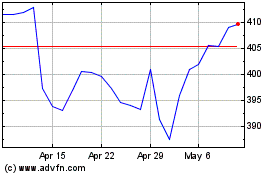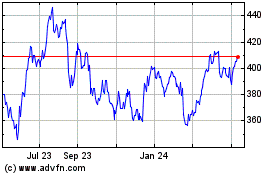Tractor maker aims to sell farmers expensive upgrades, as demand
for machinery slows
By Bob Tita
This article is being republished as part of our daily
reproduction of WSJ.com articles that also appeared in the U.S.
print edition of The Wall Street Journal (September 23, 2019).
Deere & Co.'s incoming chief executive will take charge as
the struggling tractor maker switches course from its sluggish
global expansion to a narrower focus on its home U.S. market.
With demand for farm machinery receding world-wide, dealers for
the Moline, Ill., manufacturer and industry analysts say they
expect John May to focus on cutting costs and adding new technology
and data services to its equipment that will justify higher prices
in the U.S.
Those new technologies, such as a sprayer that can differentiate
between weeds and crops when applying herbicide, aim to make seed
and fertilizer applications more efficient, increase crop yields
and alert farmers when equipment shows signs of breaking down.
"It's putting money in farmers' pockets," said Scott Kraft, a
manager at Gooseneck Implement Co., a Deere dealer in North
Dakota.
But it is a difficult time to count on U.S. farmers paying more
for tractors and harvesting combines that can cost more than
$300,000. Years of high production, falling prices for commodities
and a trade war with China that has slashed U.S. exports of crops
and livestock have squeezed farmers' incomes for the past five
years. Farm bankruptcies are on the rise.
"Everybody can't afford new equipment all the time," said Lyn
Perkins, a manager and crop-data specialist at Blanchard Equipment,
a Deere dealer in Georgia.
The focus on new technology aimed at U.S. farmers is a pivot
from current CEO Sam Allen's emphasis on selling more of Deere's
green and yellow equipment in developing markets overseas.
After he took the helm a decade ago, Mr. Allen said more
productive farms would be required to provide crops and livestock
to feed a growing middle class around the world. After the 2008
recession, Deere opened or expanded factories in Brazil, Russia,
China, India and elsewhere in pursuit of $50 billion in annual
sales by 2018.
Executives have talked less about the company's global ambitions
in recent years as slowing demand for equipment at home and
decelerating economic expansion in developing countries made the
$50 billion goal unattainable. The U.S. and Canada accounted for
57% of Deere's $33.3 billion in equipment sales last year, which
also included the company's construction and forestry machinery
lines.
Deere said in August that Mr. May, 50 years old, will become CEO
in November, while Mr. Allen will remain chairman of the company's
board.
The company has seen strong sales growth in South America and
Western Europe, where farmers use the same large equipment as
farmers in North America. In Brazil, which has been a growth market
for U.S. farm-equipment manufacturers in the past decade, Deere
gained market share in tractors at the expense of market leader
AGCO Corp.
But sales expansion has been tougher in other developing
markets. The consolidation of small farms into larger ones that
require bigger equipment has been slower than Deere and its rivals
expected, industry analysts said. Farmers had less access to
financing than anticipated. Deere's sales in Asia, Africa and the
Middle East grew last year for the second time since 2012,
according to Melius Research.
Other U.S. manufacturers, including construction-equipment maker
Caterpillar Inc. and industrial conglomerate 3M Co. that made big
bets on developing markets have also had disappointing results.
Deere's sales of farm equipment over the past three quarters are
up 2% from the year-ago period because of price increases. But
profit from those sales fell 12%, partly due to higher material
costs and rising factory expenses. Deere's gross profit margin on
equipment has been flat for most of the past decade even though
overall equipment sales have increased about 61% during that time.
Margins in manufacturing typically expand with higher production
volumes.
Deere has said it would decide this fall whether to close some
of its world-wide network of around 50 factories. The company last
month aimed to raise its operating margin to 15% by 2022 from about
10% currently.
Some U.S. farmers using technology to guide their planting
decisions say rising prices for new equipment have been offset by
savings on seed and fertilizer.
Christian Yunker, who raises dairy cattle and grows corn,
soybeans, wheat, vegetables and sod on about 7,800 acres near Elba,
N.Y., said the $200,000 he has spent on precision agriculture
equipment from Deere and other manufacturers have helped him
improve his yields.
His planters now apply more seeds on acres with a record of
higher output, and cut back on seeds on acres that have been less
fertile. He said that technology upgrade, which cost him about
$70,000 for two planters, has lowered his seed expenses by as much
as $15 an acre.
Mr. Yunker has cut his spending on equipment purchases by about
20% this year but continues to invest in technology for his
planters.
"There's advancements all the time to continue to invest in," he
said.
Write to Bob Tita at robert.tita@wsj.com
(END) Dow Jones Newswires
September 23, 2019 02:47 ET (06:47 GMT)
Copyright (c) 2019 Dow Jones & Company, Inc.
Deere (NYSE:DE)
Historical Stock Chart
From Mar 2024 to Apr 2024

Deere (NYSE:DE)
Historical Stock Chart
From Apr 2023 to Apr 2024
